Are pet birds hard to take care of? If you’re considering welcoming a feathered friend into your home, you may have wondered about the responsibilities involved. While caring for pet birds does require time and effort, it can be a fulfilling and rewarding experience with the right knowledge and approach. In this guide, we will provide you with essential tips and advice for easy pet bird care, perfect for beginners like you.
Whether you’re looking to keep pet birds for companionship or to add a touch of nature to your living space, understanding the basics of bird care is key. From providing a suitable environment to maintaining their health and ensuring mental stimulation, we will cover all the essentials to help you become a confident bird owner.
Throughout this guide, we will discuss pet bird care tips, provide a comprehensive pet bird care guide, and highlight important bird care essentials. We will also delve into low maintenance pet birds and offer guidance on pet bird maintenance.
So let’s dive in and discover just how rewarding and manageable it can be to care for pet birds!
Understanding the Cost of Pet Bird Care
Owning a pet bird brings immense joy and companionship, but it’s essential to understand the financial obligations that come with it. The cost of caring for a pet bird can vary depending on the breed and type of bird you choose. From the initial expenses of purchasing a suitable cage and accessories to the ongoing costs of providing a balanced diet and necessary supplies, it’s important to be prepared for the financial commitment involved.
The Cost Breakdown
Let’s take a closer look at some of the key expenses associated with pet bird care:
| Expense | Average Cost Range |
|---|---|
| Bird Food | $10 – $30 per month |
| Bird Cage | A few hundred to over a thousand dollars |
| Parrot Accessories | Varies based on specific needs |
Note: The above costs are approximate and can vary depending on factors such as bird size, dietary requirements, and personal preferences.
When it comes to pet bird food, the monthly expenses can range from $10 to $30. It’s important to provide a varied and nutritionally balanced diet, including seeds, pellets, fresh fruits, and vegetables. Depending on your bird’s appetite and dietary needs, the cost can fluctuate.
Investing in a suitable bird cage is crucial for your pet’s comfort and safety. The cost of bird cages can vary significantly depending on factors such as size, materials, and additional features. While some basic cages may be available for a few hundred dollars, larger and more elaborate cages can cost over a thousand dollars. It’s important to choose a cage that provides ample space for your bird to move around comfortably.
Parrot accessories, such as perches, toys, and grooming supplies, are additional costs that should be taken into account. The expense for these items will depend on your preferences and the specific needs of your bird.
Understanding the Long-Term Investment
It’s crucial to consider the long-term investment involved in pet bird care. Birds can live for several decades, with some species even reaching 50 years or more. This means that you’ll be providing for your feathered friend for many years to come, including covering ongoing expenses such as food, cage maintenance, and healthcare.
“The love and companionship of a pet bird are priceless, but it’s important to plan and budget for the financial commitment that comes with it. Providing a happy and healthy life for your feathered friend requires balancing care and cost.”
By understanding the cost of pet bird care upfront, you can ensure that you are financially prepared to provide the best possible care for your feathered companion. It’s important to prioritize your bird’s well-being and invest in their care to create a fulfilling and enriching life together.
Maintaining a Clean Environment for Your Bird
Birds can be messy creatures, and it’s important to prioritize cleanliness to ensure their health and well-being. Regular and thorough cleaning of your bird’s cage, toys, and feeding accessories is crucial for maintaining a safe and comfortable living environment.
Proper cage hygiene significantly reduces the risk of bacterial and fungal infections that can harm your feathered friend. To keep your bird happy and healthy, follow these essential cleaning tips:
1. Daily Cleaning
Make it a habit to clean your bird’s cage every day. Remove any soiled bedding or papers, and wipe down surfaces with a mild bird-safe disinfectant. Regularly clean and refill the food and water dishes to ensure freshness and prevent contamination.
2. Thorough Cage Cleaning
On a weekly basis, conduct a deeper cleaning of the entire cage. Remove all perches, toys, and accessories, and wash them thoroughly with warm water and bird-safe soap. Rinse well to remove any soap residue before allowing them to dry completely. Similarly, wipe down the cage bars, floors, and walls with a mild disinfectant solution, ensuring all corners and crevices are properly cleaned.
3. Safe Toy Cleaning
Bird toys can harbor bacteria, dirt, and droppings, so it’s essential to keep them clean. Inspect toys regularly for signs of wear and tear, and discard damaged ones. Clean toys weekly by soaking them in hot water with a mild bird-safe disinfectant, scrubbing away any residue, and rinsing them thoroughly. Allow the toys to air dry completely before returning them to your bird’s cage.
4. Bedding Changes
If you use bedding or cage liners, remove and replace them daily to maintain a clean and odor-free environment for your bird. Fresh bedding helps absorb droppings and reduces the risk of contact with waste, promoting a healthier living space.
Remember, maintaining proper hygiene is essential not only for your bird’s physical health but also for their mental well-being. A clean environment promotes a sense of security and comfort, allowing your pet bird to thrive.
“Regular and thorough cleaning of your bird’s cage, toys, and feeding accessories is crucial for maintaining a safe and comfortable living environment.”
By prioritizing cleanliness and following these cleaning practices, you create a nurturing environment for your bird, reducing the risk of disease and ensuring their overall well-being.
| Cleaning Tasks | Frequency |
|---|---|
| Daily cage cleaning | Every day |
| Thorough cage cleaning | Once a week |
| Toy cleaning | Once a week |
| Bedding changes | Every day |
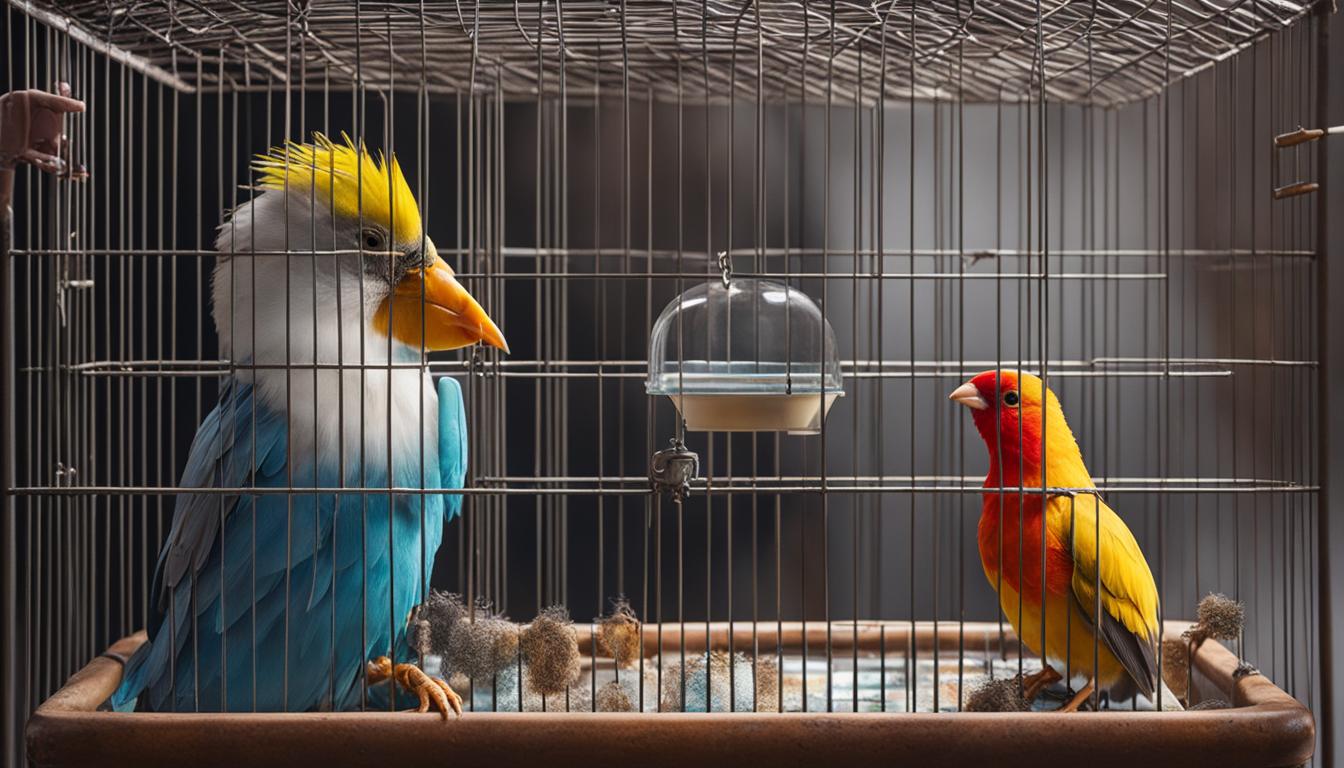
Understanding the Lifespan of Pet Birds
When deciding to bring a pet bird into your life, it’s important to understand the lifespan and long-term commitment that comes with it. Pet birds have incredibly long lifespans, ranging from 20 to 50 years or even longer.
This extended period of time should not be taken lightly. Bird owners must be prepared to provide care, love, and companionship to their feathered friends throughout their entire lives.
Unlike other small pets, such as hamsters or guinea pigs, birds can be lifelong companions. This means that when you bring a bird into your home, you are committing to caring for them for several decades. Understanding the longevity of these magnificent creatures can help you make an informed decision about whether they are the right pet for you and your lifestyle.
Knowing the potential lifespan of a pet bird allows you to plan ahead and provide the necessary care and attention they need throughout their lives. It also helps you establish a strong bond and create lasting memories with your feathered friend.
Whether you choose a parrot, cockatiel, budgie, or any other bird species, their long lifespan means that they become an integral part of your family for many years to come. So, before bringing a pet bird home, take a moment to consider the responsibility and commitment involved in providing a happy and fulfilling life for your avian companion.
Lifespan Comparison of Common Pet Birds
| Bird Species | Lifespan |
|---|---|
| African Grey Parrot | 40-60 years |
| Cockatiel | 15-20 years |
| Budgerigar (Budgie) | 5-10 years |
| Lovebird | 10-15 years |
| Macaw | 50-80 years |
| Cockatoo | 40-70 years |
Birds have remarkable lifespans, and their longevity is a testament to their unique nature and the care they receive from their owners. Investing time, effort, and love into their well-being ensures a fulfilling and immensely rewarding journey as a pet bird owner.
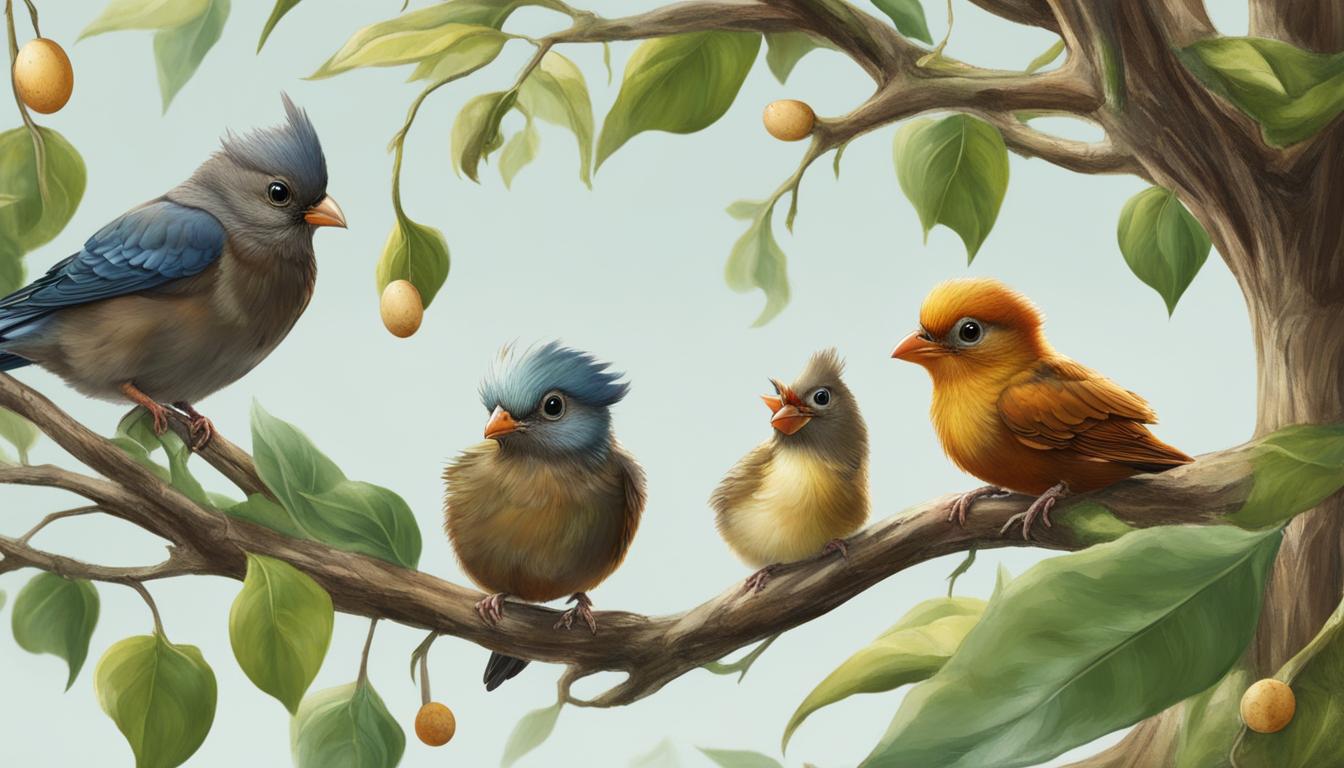
Providing Exercise for Your Bird
Like humans, birds need regular exercise to stay healthy and maintain proper body functions. Creating an environment where your bird can fly, climb, and play is important. Providing toys, swings, and perches for your bird to engage in physical activity is essential for their overall well-being.
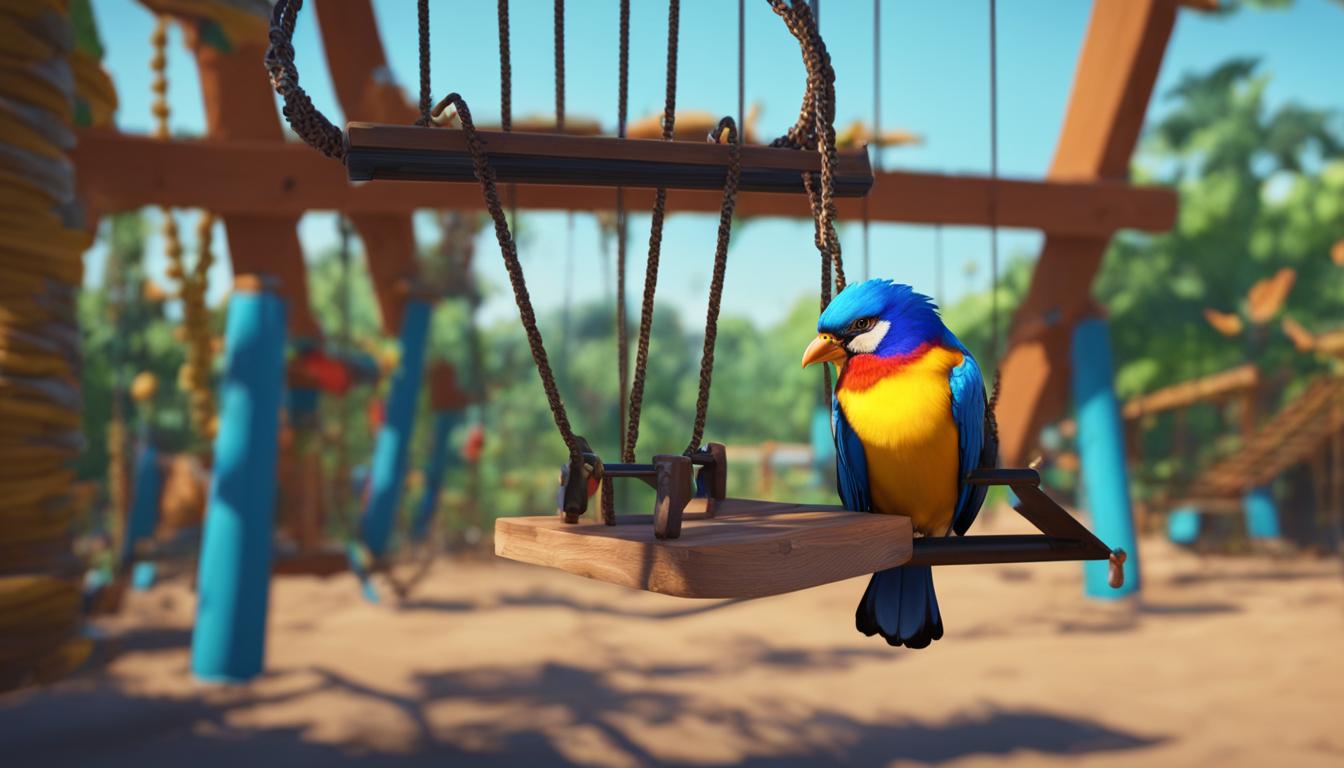
Physical activity is not only beneficial for your bird’s physical health but also for their mental stimulation. Exercise helps prevent obesity, muscle atrophy, and boredom-related behaviors. It promotes proper digestion, circulation, and overall vitality.
The Importance of Fly Time
Allowing your bird to fly freely within a controlled environment is one of the best forms of exercise. It mimics their natural behavior and allows them to stretch their wings, improve their coordination, and strengthen their muscles.
“Fly time is crucial for your bird’s well-being. It not only keeps them physically fit but also fulfills their instinctual need for flight.”
When providing fly time, ensure that the space is safe and free from hazards such as open windows, ceiling fans, or other pets. Close all doors, windows, and curtains to prevent escape or accidents. Supervise your bird during fly time to ensure their safety and avoid potential injuries.
Engaging Toys and Enrichment
Toys are an excellent way to encourage physical activity and mental stimulation for your bird. Choose toys that cater to their natural instincts, such as foraging toys, puzzle toys, or toys that encourage climbing and swinging.
Rotate your bird’s toys regularly to keep them engaged and prevent boredom. Introduce new toys gradually to avoid overwhelming them. Ensure that the toys are made of bird-safe materials and do not pose any choking hazards.
Perches and Climbing Opportunities
Providing a variety of perches and climbing opportunities in your bird’s cage or play area is beneficial for their physical exercise. Different perch sizes and textures help strengthen their feet and promote healthy foot muscles.
Consider adding natural branches, rope perches, or ladders to create a stimulating environment for your bird to explore and engage in climbing activities. These additions not only provide exercise but also allow your bird to satisfy their natural curiosity and explore their surroundings.
Bird Exercise Ideas
| Exercise Activities | Description |
|---|---|
| Flight training | Teach your bird to fly from one perch to another by using positive reinforcement techniques. Gradually increase the distance and difficulty level to challenge their flying abilities. |
| Obstacle courses | Create an obstacle course using bird-safe materials such as tunnels, hoops, and perches placed at varying heights. Encourage your bird to navigate through the course, stimulating both physical and mental exercise. |
| Dancing sessions | Play music and encourage your bird to dance along. Clapping, swaying, or imitating dance moves can be an entertaining and enjoyable form of exercise for your bird. |
| Interactive play | Engage your bird in interactive playtime using toys that encourage tossing, rolling, or fetching. This form of play promotes physical activity and stimulates their natural foraging instincts. |
Remember to supervise your bird during exercise sessions and provide positive reinforcement to encourage their participation. Each bird is unique, so observe their preferences and tailor exercise activities to suit their individual needs and abilities.
Mental Stimulation for Pet Birds
Mental stimulation plays a vital role in ensuring the cognitive health and overall happiness of your pet birds. Just like humans, birds need mental exercise to prevent boredom and maintain their well-being. Engaging in activities that challenge their intelligence and teach them new skills is essential. One effective way to provide mental stimulation is through bird training and teaching them tricks.
Training your bird not only stimulates their mind but also strengthens the bond between you and your feathered friend. It allows you to communicate and interact with them in a unique way. By spending quality time together and engaging in training sessions, you can establish trust and create a deeper connection with your bird.
“Training a bird is a rewarding experience that benefits both the bird and the owner. It enhances the bird’s cognitive abilities and provides them with valuable mental stimulation, while also allowing the owner to witness the intelligence and capabilities of their feathered companion.”
When starting the training process, it’s important to keep a few things in mind:
Start with Basic Commands
Begin with teaching simple commands such as “step up” or “step down.” These commands help your bird understand how to respond to your cues and establish a foundation for further training.
Use Positive Reinforcement
Positive reinforcement is the key to successful bird training. Reward your bird with treats, praise, or affection whenever they perform a desired behavior or learn a new trick. This reinforces positive associations and motivates them to continue learning.
Be Patient and Consistent
Training takes time and patience. Birds are intelligent creatures, but they learn at their own pace. Be consistent with your training sessions and repeat commands or tricks until your bird understands and responds correctly.
Make Training Fun
Keep training sessions fun and engaging for both you and your bird. Use interactive toys, treats, and positive reinforcement to make the learning experience enjoyable. Birds are more likely to participate and learn when they’re having fun.
Explore Interactive Toys
Interactive toys are another great tool for providing mental stimulation to your pet bird. These toys allow them to engage in problem-solving activities and keep their minds active. Choose toys that are suitable for your bird’s size, breed, and capabilities.
“Tricks and training offer a way to keep your bird mentally stimulated, prevent boredom, and promote a healthier, happier life.”
Regular mental stimulation through training and interactive play is essential for the well-being of your pet bird. It helps prevent behavioral issues caused by boredom and improves their overall quality of life. So, set aside some dedicated time each day to train and play with your feathered companion, and watch as they flourish and showcase their unique abilities.
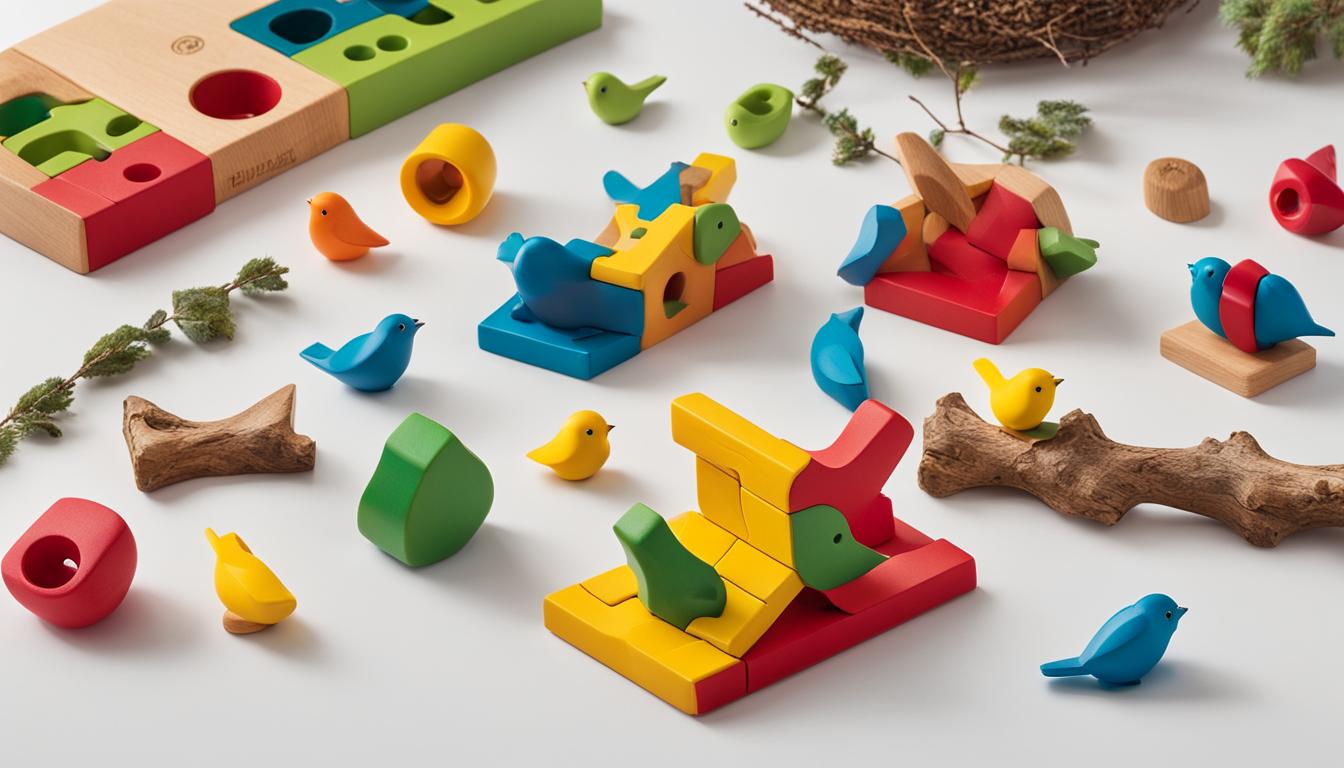
| Benefits of Mental Stimulation for Pet Birds | Tricks to Teach Your Bird |
|---|---|
|
|
The Importance of Socializing Your Bird
Birds are highly social creatures and thrive when they have regular opportunities for socialization. While human interaction is crucial for their well-being, providing them with bird companionship can also have numerous benefits. Having a bird buddy not only offers companionship but also reduces the risk of loneliness and behavioral problems.
Birds are naturally social animals that form strong bonds within their flock. When they are kept as pets, it’s essential to recognize and fulfill their social needs to ensure their emotional and mental well-being. Interacting with other birds allows them to engage in natural behaviors, communicate, and establish social hierarchies.
“Birds are highly social creatures and thrive when they have regular opportunities for socialization.”
Introducing a bird companion to your pet bird’s life can have a positive impact on their overall happiness and quality of life. It provides them with a constant companion and a playmate they can engage with in their own bird-like activities. Having a feathered friend by their side can help reduce boredom and alleviate loneliness, ultimately leading to a healthier, happier bird.
Bird companionship also offers an additional layer of security for your pet bird. In the wild, birds live in flocks to ensure safety from predators and to support each other in various activities such as foraging and finding shelter. By providing a bird companion, you create an environment that simulates the natural social structure, making your pet bird feel more secure and confident.
Choosing the Right Bird Companion
When selecting a bird companion for your pet, it’s important to consider compatibility in terms of species, size, and temperament. Some species have a higher likelihood of forming bonds with other birds, while others may be more territorial or solitary.
It’s also crucial to introduce the new bird companion properly to prevent any aggression or stress. Gradual introductions and supervised interactions can help ensure a smooth bonding process, allowing the birds to establish their own relationship at a comfortable pace.
Additionally, providing enough living space and resources such as perches, toys, and feeding stations is essential to prevent competition and promote harmonious cohabitation between the birds.
| Bird Species | Compatibility | Size |
|---|---|---|
| Budgerigar (Budgie) | Highly social, usually friendly with other budgies | Small to medium |
| Cockatiel | Can form strong bonds with other cockatiels | Medium |
| Lovebird | Often form close pairs, consider pairs or groups | Small |
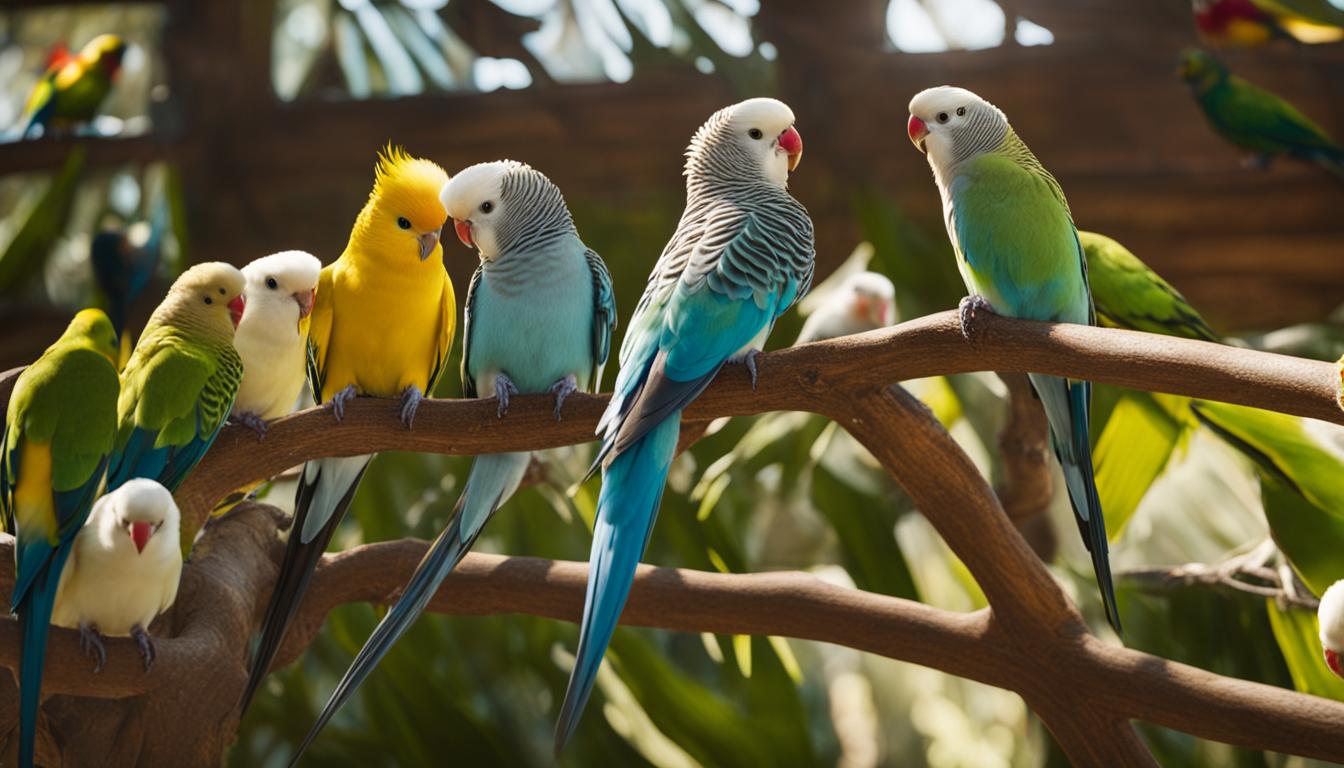
As with any major change in a bird’s environment, it’s crucial to monitor the birds’ behavior and well-being during the socialization process. Pay attention to any signs of aggression, stress, or discomfort and provide appropriate interventions if necessary.
The introduction of a bird companion can provide your pet bird with a sense of belonging, mental stimulation, and a valuable social connection. It is important to remember that, just like humans, each bird has its own unique personality and preferences, so not every bird may immediately take to having a companion. Patience and understanding are key to nurturing a successful bird companionship.
Recognizing Common Bird Diseases
Like any pet, birds can be susceptible to various diseases. It’s important to be aware of common bird illnesses so that you can take prompt action if your feathered friend shows any signs of illness. Here are some of the most frequently encountered bird health issues:
Candida
Candida, also known as yeast infection, is caused by an overgrowth of naturally occurring yeast in a bird’s digestive system. It can lead to problems such as weight loss, diarrhea, and respiratory difficulties. Prompt veterinary care is essential to manage this illness.
Psittacine Beak & Feather Disease
Psittacine Beak & Feather Disease (PBFD) is a viral disease that primarily affects parrots and cockatoos. It causes feather abnormalities, beak deformities, and immune system dysfunction. Unfortunately, PBFD is incurable, so prevention through vaccination is crucial.
Pacheco’s Disease
Pacheco’s disease is a highly contagious viral infection that affects parrots. It can spread rapidly and cause liver damage, neurological symptoms, and sudden death in infected birds. Quarantine and vaccination are essential preventive measures.
Parasites
Parasites, such as mites and lice, can infest a bird’s feathers and skin, leading to itching, feather damage, and discomfort. Regular vet check-ups and appropriate preventive treatments can help keep parasites at bay.
Egg Binding
Egg binding occurs when a female bird is unable to lay her eggs properly. It can be a life-threatening condition and requires immediate veterinary intervention. Symptoms may include prolonged straining, fluffed feathers, and decreased appetite.
If you notice any signs of illness in your bird, it’s essential to seek professional veterinary care. With prompt diagnosis and treatment, many bird illnesses can be managed or even prevented. Remember, your bird’s health and well-being are in your hands!
Proper Petting Techniques for Birds
When it comes to petting and handling birds, it’s important to understand their preferences and boundaries to ensure a positive interaction. Gentle strokes from the head to the tail are generally well-received by most birds. This helps them relax and enjoy the physical contact with you. Remember to approach your bird calmly and respect their personal space.
Some birds might have specific areas they enjoy being petted, such as the back of the head or beneath the wings. By observing their body language and reactions, you can learn where your bird likes to be touched. Avoid any areas that seem sensitive or uncomfortable for them.
Creating Trust and Comfort
Building trust with your bird is essential for successful petting sessions. Start by spending time near their cage and talking to them in a calm and soothing voice. Offer treats and rewards to create positive associations.
Once your bird is comfortable with your presence, approach them slowly and gently. Extend your hand and allow them to come to you if they’re willing. Avoid making sudden movements or being too forceful, as this can startle or intimidate the bird.
Remember, every bird is unique and may have different preferences. Getting to know your bird’s comfort zones will help ensure a positive and enjoyable petting experience for both of you.
Warning Signs to Watch For
It’s crucial to pay attention to your bird’s body language and respect their signals during petting sessions. If they show signs of stress, fear, or discomfort, it’s essential to back off and give them space. Some signs to watch for include:
- Feathers fluffing up or standing on end
- Wings spreading out or lifting slightly
- Biting or pecking at your hand
- Attempting to move away or escape
- Vocalizations that indicate distress or agitation
Always remember that birds are sensitive creatures, and their well-being should be prioritized above all else. If your bird consistently shows signs of discomfort during petting, it might be best to seek guidance from an avian veterinarian or an experienced bird behaviorist.
Proper petting techniques not only provide physical stimulation for your bird but also helps to strengthen the bond between you. By respecting their boundaries and communicating through gentle touch, you can create a loving and trusting relationship with your feathered friend.
| Petting Do’s | Petting Don’ts |
|---|---|
| Stroke your bird’s feathers gently and in the direction they naturally lie. | Pet your bird on their belly or tail, as these areas can be sensitive for some birds. |
| Observe signs of enjoyment, such as relaxed body language or gentle vocalizations. | Force your bird to be petted if they show signs of discomfort or resistance. |
| Offer treats and rewards to create positive associations with petting. | Rush your bird into accepting petting before they are ready or comfortable. |
| Respect your bird’s personal space and allow them to initiate contact. | Surprise your bird with sudden movements or loud noises during petting. |
Choosing the Right Pet Bird
When it comes to choosing a pet bird, careful consideration is key. Different bird species have varying needs and characteristics, and it’s important to select a bird that aligns with your experience level and lifestyle. Whether you’re a beginner or an experienced bird owner, finding a bird species suitable for your circumstances is essential for a successful pet-bird relationship.
For beginners, bird species like budgies and cockatiels are excellent choices. These small to medium-sized birds are known for their friendly and social nature, making them great companions. They are relatively easy to care for and adapt well to different environments. Budgies, also known as parakeets, are colorful and playful birds that can be trained to perform tricks. Cockatiels, on the other hand, are known for their charming personalities and melodic vocalizations.
However, if you have more experience with birds or are willing to invest additional time and effort, you may consider larger or more challenging species. Parrots, such as African Greys and Amazons, are highly intelligent and require mental stimulation and social interaction. These birds can develop extensive vocabularies and form deep bonds with their owners. However, they also demand more specialized care and a spacious living environment.
Researching Bird Species
Before making a decision, it’s crucial to thoroughly research different bird species and their specific needs. Consider factors like their size, lifespan, dietary requirements, and exercise needs. Don’t forget to take into account any potential allergies or sensitivities you or your family members may have.
Remember that choosing a pet bird is a commitment that can span decades. Take your time to understand the intelligence, social needs, and potential challenges associated with different bird species before making your final choice.
Additionally, interacting with the birds before bringing one home can give you a better sense of their personalities and compatibility with your lifestyle. Visit reputable breeders, bird rescues, or aviaries to observe and interact with different species. By doing so, you can make an informed decision that matches your expectations and ensures a harmonious and fulfilling relationship with your feathered friend.
Keep in mind that owning a pet bird is a long-term commitment that requires time, effort, and financial resources. By selecting the right pet bird for your circumstances, you can embark on a rewarding journey filled with companionship, laughter, and the joy that comes from sharing your life with a feathered companion.
The Rewards and Challenges of Pet Bird Ownership
Owning a pet bird can be a truly rewarding experience. These feathered companions bring joy, companionship, and a unique presence into your life. Forming a strong bond with your pet bird allows you to develop a deep connection and share special moments together.
One of the most appealing aspects of having a bird as a companion is their unique personalities. Whether they are talkative parrots, playful budgies, or graceful cockatiels, each bird has its own characteristics and quirks that make them fascinating to be around. You’ll be amazed by their ability to mimic sounds, learn tricks, and even engage in simple conversations.
However, owning a pet bird also comes with its challenges. One of the main hurdles is the time and effort required for proper care. Birds need daily attention, including feeding, cleaning their cage, and providing mental and physical stimulation. Additionally, their lifespan can be quite long, so a long-term commitment to their well-being is essential.
Another challenge of pet bird ownership is their delicate nature. Birds can be sensitive to changes in their environment and require a careful balance of temperature, lighting, and humidity. It’s important to educate yourself on their specific needs to ensure they thrive in their living space.
Despite the challenges, the rewards of pet bird ownership far outweigh the difficulties. The bond you form with your feathered friend is truly special and brings immeasurable joy into your life. Their entertaining antics and affectionate nature make every day brighter and more fulfilling.
“Having a pet bird is like having a constant source of companionship. They’re always there, ready to brighten your day with their presence and unique personalities.”
In conclusion, owning a pet bird is a wonderful experience that comes with both rewards and challenges. The joy of forming a bond with your feathered companion and experiencing their distinct personalities is unparalleled. However, it’s important to be prepared for the time, effort, and long-term commitment required to provide proper care and ensure they live a fulfilling life.
Conclusion
Caring for pet birds requires dedication, time, and financial commitment. Despite the initial challenges, it is a rewarding experience that allows you to form a strong bond with your feathered companion. By following proper guidelines and acquiring the necessary knowledge, you can ensure a happy and healthy life for your pet bird.
Remember to provide a clean living environment, with regular cleaning and hygiene practices to prevent the spread of diseases. Regular exercise and mental stimulation are also crucial for your bird’s well-being. Spending quality time with your bird, providing enrichment activities, and socializing them with humans and other birds contribute to their overall happiness and contentment.
Additionally, it’s important to choose the right bird species that suits your level of experience and lifestyle. Researching their specific needs, such as diet, habitat requirements, and socialization needs, will help you make an informed decision.
In summary, pet bird care requires commitment and effort, but the joy and fulfillment of having a feathered friend as a companion makes it all worthwhile. With proper care, a pet bird can bring immeasurable happiness and become an integral part of your life.
FAQ
Are pet birds hard to take care of?
Caring for pet birds can be manageable with proper care and knowledge.
What are some pet bird care tips for beginners?
Some basic tips for pet bird care include providing a balanced diet, maintaining cleanliness, and providing mental and physical stimulation.
How much maintenance do pet birds require?
Pet birds require daily care, including cleaning their cage, providing fresh food and water, and spending quality time with them.
What are some low maintenance pet birds?
Some low maintenance pet bird options include budgies, cockatiels, and canaries.
How long do pet birds live?
Pet birds can live for 20 to 50 years or even longer, so owning a bird is a long-term commitment.
How can I provide exercise for my bird?
You can provide exercise for your bird by creating an environment where they can fly, climb, and play. Offer toys, swings, and perches for physical activity.
How can I mentally stimulate my pet bird?
Mental stimulation for pet birds can be achieved through teaching them tricks, basic commands, and engaging them in interactive play.
Do pet birds need socialization?
Yes, pet birds are social animals and benefit from regular socialization. Providing human interaction and considering a bird companion can help keep them happy and healthy.
What are common bird illnesses to watch for?
Common bird illnesses include candida, Psittacine Beak & Feather Disease, Pacheco’s disease, parasites, and egg binding.
How should I handle and pet my bird?
Gentle strokes from head to tail are generally well-received by birds. It’s important to understand their comfort zones and boundaries to avoid causing stress.
How do I choose the right pet bird?
When choosing a pet bird, consider factors like your experience, the bird’s size and needs, and their suitability to your lifestyle and living environment.
What are the rewards and challenges of owning a pet bird?
Owning a pet bird can bring joy and companionship but also requires time, effort, and long-term commitment for their proper care and well-being.
Source Links
- https://beautyofbirds.com/are-parrots-hard-to-take-care-of/
- https://azeah.com/birds/tips-keeping-your-pet-bird-active
- https://wagwalking.com/daily/7-things-to-know-before-getting-a-pet-bird

My name is Shane Warren, the author behind Your Bird Buddy – your ultimate guide to the wonderful world of birds! Unleash your inner avian explorer as we delve into a vibrant library of knowledge dedicated to all things feathered. From learning about diverse bird species from across the globe to understanding their captivating habitats and behaviors, I’m here to fuel your passion for these magnificent creatures. Not only that, but I also provide valuable insights on being a responsible and informed pet bird owner. Join our vibrant community and let’s celebrate the feathered wonders of the world together – one chirp at a time. And be sure to join our Your Bird Buddy Community over on Facebook!

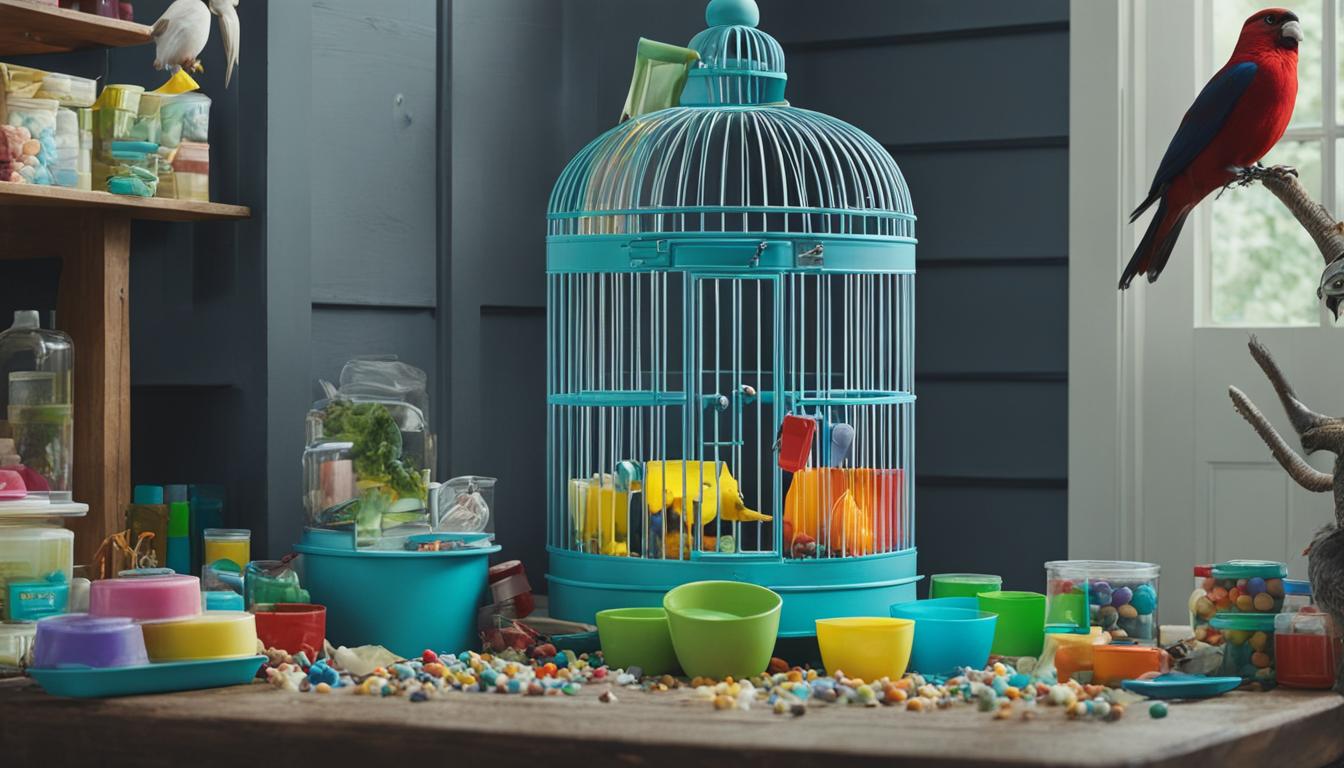
Comments are closed